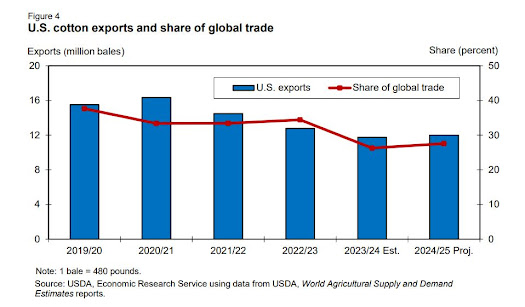U.S. Cotton Crop Forecast Reduced but Highest in 3 Years.
Thee USDA’s first survey-based estimate of the 2024/25 U.S. cotton crop is 15.1 million bales. Although 11 percent below last month’s projection, the estimate is 25 percent above last season’s final estimate of 12.1 million bales. The 2024 cotton planted area estimate of nearly 11.2 million acres is based on all available data, including the latest certified acreage from the Farm Service Agency. This season’s cotton planted area is 9 percent above 2023/24, as cotton prices heading into planting season were more favorable relative to other crops. With improved moisture conditions compared with a year ago across much of Texas—the largest cotton-producing State—the early-season U.S. abandonment projection is reduced compared with last year. A U.S. abandonment rate of 23 percent projected for 2024/25 is below the year before and less than half the 47 percent record for 2022/23. U.S. cotton harvested acreage is forecast at 8.6 million acres, the highest in 3 years. The U.S. cotton yield is projected at 840 pounds per harvested acre in 2024/25, 50 pounds below the 3-year average. Upland cotton production in 2024/25 is forecast at approximately 14.6 million bales, 24 percent above 2023/24 and the largest crop since 2021/22. During the past 20 years, the August upland production forecast was above the final estimate 12 times and below it 8 times. Past differences between the August forecast and the final production estimates indicate a two out of three chance for the 2024/25 upland crop to range between 13.1 million and 16.0 million bales. U.S. upland production expectations are higher for three of the Cotton Belt regions this season compared with last year while the Southeast is forecast nearly identical to 2023/24 (figure 2). In contrast, the Delta crop is projected above the 5-year average while the other regions are expected to fall short of that mark.
Based on the August estimate, 2024/25 Southwest upland cotton production is projected at 5.1 million bales, the third lowest in a decade but above the drought-reduced crops of last season and 2022/23. Crop conditions this season are better than the 5-year average but conditions during the next 2 months will influence production considerably. Southwest abandonment in 2024/25 is currently projected at 37 percent, below the 5-year average of 45 percent. The Southwest yield is estimated at 602 pounds per harvested acre in 2024/25, the lowest since 2011/12. The Southwest is expected to account for 35 percent of total U.S. upland production in 2024/25, compared with 26 percent last season. In the Delta, the 2024/25 cotton crop is estimated at nearly 4.7 million bales, above last season and the 5-year average. Increased area this season is slightly offset by a reduction in yield from 2023/24’s record of 1,219 pounds per harvested acre to 1,160 pounds. The Delta region is expected to contribute 32 percent of U.S. upland production in 2024/25. For the Southeast, 2024/25 production is projected at 4.3 million bales, similar to last season but below the 5-year average, while the yield is forecast at 909 pounds per harvested acre, the lowest in 4 years. The Southeast region is estimated to produce 30 percent of the U.S. upland crop this season. In the West, 2024/25 upland production is estimated to increase from a nine-decade low to 445,000 bales, as harvested area rebounds from the smallest in over a century and yield (1,494 pounds per harvested acre) is also expected to rise. The West is expected to account for 3 percent of the total U.S. upland crop. Extra-long staple (ELS) cotton production is estimated at 553,000 bales in 2024/25, considerably (75 percent) above last season as California responds with increased area. A higher ELS national yield—estimated at 1,383 pounds per harvested acre—also contributes to the larger 2024/25 crop and is projected to be the highest in 5 years. U.S. cotton crop development is running ahead of last season and the 5-year average. Cotton area setting bolls reached 74 percent as of August 11, compared with 69 percent in 2023 and 73 percent for the 2019–23 average. In addition, 13 percent of the area had bolls opening, compared with 12 percent for last year and the 5-year average. Bolls opening in Arizona reached 64 percent by August 11, compared with the 2019–23 average of 33 percent, while Arkansas had bolls opening on 28 percent of its area, compared with a 5-year average of 6 percent. U.S. cotton crop conditions remain above the previous 2 years and are near the 5-year average (figure 3). As of August 11, 46 percent of the U.S. cotton area was rated “good” or “excellent,” compared with 36 percent in 2023, while 25 percent was rated “poor” or “very poor,” compared with 43 percent a year ago.





Comments
Post a Comment